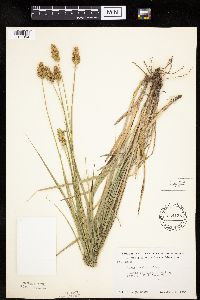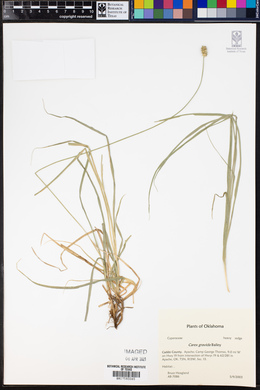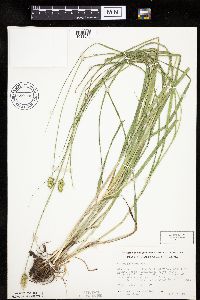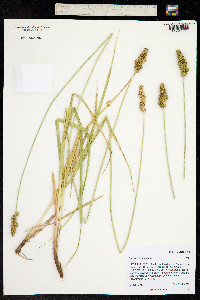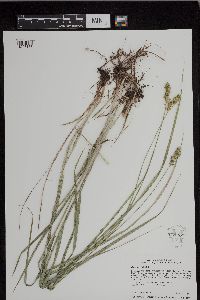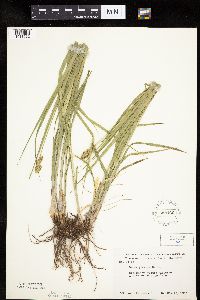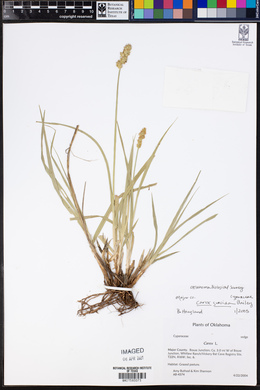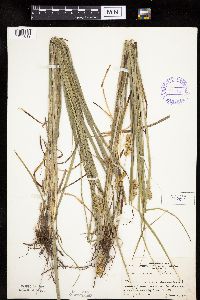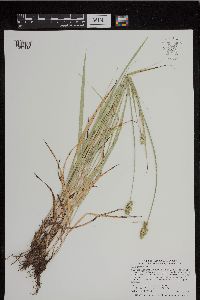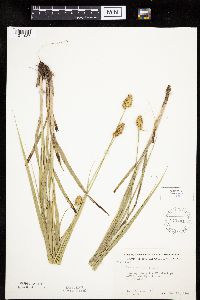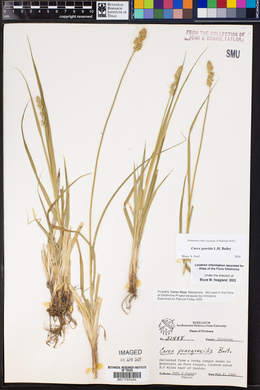Carex gravida
|
|
|
|
Family: Cyperaceae
Heavy Sedge
[Carex gravida f. laxifolia (L.H.Bailey) Kük., moreCarex gravida var. laxifolia L.H.Bailey] |
Plants without conspicuous rhizomes. Culms (20-)30-100 cm, 2.5-8 mm wide basally, 0.7-1.6 mm wide distally. Leaves: sheaths usually loose, proximally green-and-white-striped, not white spotted, with conspicuous transverse veins on back, fronts hyaline, sometimes transversely rugose and red dotted, thin, white or hyaline and fragile at mouth; ligules 2-7 mm, shorter to longer than wide; widest leaf blades (3-)4-8 mm wide. Inflorescences with 5-15 spikes, 1-5 cm × 8-15 mm, occasionally compound, then somewhat larger; proximal bracts to 3 cm; spikes with 5-15 ascending to spreading perigynia; proximal internodes shorter than to 1.5 times as long as proximal spikes. Pistillate scales hyaline or brown with green, 1-3-veined center, ovate, 2.6-4.4 × 1.3-2.4 mm, body shorter to slightly longer than perigynium, apex acuminate to short-awned. Anthers 1.5-3 mm. Perigynia pale green to pale brown, veinless or 3-7(-12)-veined abaxially, rarely veined adaxially, 3.5-5.5 × 2-3 mm, body somewhat spongy, base thickened, margins serrulate distally; beak 0.6-1.6 mm, apical teeth 0.3-1 mm. Achenes circular to elliptic- circular, 1.8-2.1 × 1.6-2 mm. Fruiting late spring. Prairies, ditches, swales, open forests, usually on calcareous soils; 100-1400 m; Man., Ont., Sask.; Ark., Colo., Ill., Ind., Iowa, Kans., Ky., Mich., Minn., Mo., Mont., Nebr., N.Mex., N.C., N.Dak., Ohio, Okla., Pa., S.Dak., Tenn., Tex., Va., Wis., Wyo. Carex gravida is introduced in North Carolina.
Densely cespitose; stems 3-6 dm, rough above; lvs 4-8 mm wide, the sheath loose, ventrally thin and pale, dorsally septate-nodulose and white with green veins or mottled; infl dense, ovoid or oblong, 1-3 cm, at least the lower spikes distinguishable; bracts setaceous, shorter than the head; scales with a slender tip surpassing the base of the beak of the subtended perigynium; perigynia yellowish- brown, shining, ovate, abruptly contracted into a rough-margined, bidentate beak about a third as long as the body; achene suborbicular, the style-base expanded into an ovoid body 0.8 נ0.3-0.5 mm; 2n=58. Dry open soil and prairies; O. and sw. Ont. to Minn., S.D., and Wyo., s. to Ky. and Tex. Two weak vars. Gleason, Henry A. & Cronquist, Arthur J. 1991. Manual of vascular plants of northeastern United States and adjacent Canada. lxxv + 910 pp. ©The New York Botanical Garden. All rights reserved. Used by permission. From Flora of Indiana (1940) by Charles C. Deam Known in Indiana only from the prairie area in the westernmost tier of counties where it is found on sandy bur oak ridges and sandy and gravelly railroad embankments. Reported from Lake County by Peattie and by Pepoon but no authentic specimens could be found. The Lake County reports were probably based upon specimens of C. Muhlenbergii in the Field Museum and University of Wisconsin herbaria which were collected by Umbach and distributed as C. gravida. The report from Fayette County by Deam was based upon a specimen of C. aggregata which was referred to C. gravida by Mackenzie. Deam no. 43219 is intermediate between C. gravida and its var. lunelliana. [Variety lunelliana, a plant with abruptly beaked perigynia and leaf blades often 6-8 mm wide, grows] on sandy roadsides and railroad embankments in the westernmost tier of counties where it is rare. Some of the Benton County specimens intergrade slightly with the species but the Vigo County plants from very sandy soil on a roadside knoll 5 miles north of Terre Haute are a good match with the type material of C. lunelliana. ...... Indiana Coefficient of Conservatism: C = 5 Wetland Indicator Status: FACU |
|
|
|










